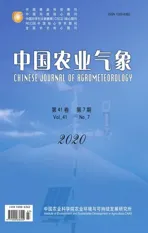大跨度外保温型塑料大棚小气候环境测试*
2020-07-24董晓星余路明李胜利
董晓星,黄 松,余路明,李胜利**
大跨度外保温型塑料大棚小气候环境测试*
董晓星1,黄 松2,余路明1,李胜利1**
(1.河南农业大学园艺学院,郑州 450002;2.信阳农林学院,信阳 464000)
为探明大跨度外保温型塑料大棚内部的小气候环境,有效利用该大棚进行生产,周年监测了大棚内外的温度、相对湿度和光照环境,并对其环境调控效果进行分析。结果表明:大跨度外保温型塑料大棚冬季保温性能良好,地温高且稳定,在河南驻马店地区1月平均室内气温为10.9℃,平均室内地温12.7℃。室内最低气温6.8℃,室内最低地温12.3℃,分别较露地高8.9℃和9.5℃。夏季棚内气温和地温均高于露地,但气温高出幅度较小。棚内晴天、透光率为51.8%~67.5%,受位于棚顶保温被卷的影响,白天棚内存在一条2.0~3.5m宽的移动阴影带。棚内相对湿度大,11月-翌年2月期间,白天和夜间棚内相对湿度均接近饱和。在驻马店地区,大跨度外保温型塑料大棚能基本满足喜温类果菜所需的环境条件,可用于喜温类果菜的周年生产,具有推广应用价值。
大跨度;外保温型;塑料大棚;温度;湿度;光照
中国北方主要园艺设施类型是塑料大棚和日光温室。塑料大棚土地利用率和建造效率高,可进行春提前和秋延后果菜栽培,但在北方地区无法进行越冬生产。日光温室是北方最重要的保温设施[1],可进行园艺作物的早春茬、秋冬茬和越冬一大茬喜温果菜的生产[2]。但是,目前生产中常用的日光温室跨度多为8~10m,后墙多为土墙和砖墙,存在栽培面积小、墙体建造效率低和土地利用率不高的问题,不能满足温室结构大型化、作业轻简化和建造装配化的要求[3-6]。
为解决上述问题,探索新的园艺设施类型,李胜利等[7]设计了巨型塑料大棚,发现通过增大棚室体积容量,增强其缓冲能力,室内温度较普通塑料大棚可提高1.2~1.6℃;崔世茂等[8]设计了大棚型温室,建造成本较日光温室低,光照条件更好;武莹等[9]研究了大跨度非对称塑料大棚的温光性能,发现其冬季最低气温较日光温室低2.1℃,较普通塑料大棚高16.3℃,春秋季最低气温仅比日光温室低0.5℃,较普通塑料大棚高4.0℃。韩丽蓉等[10]设计了下沉式大跨度大棚型温室,在陕西榆林地区1月典型天气下的气温和地温均高于日光温室,建造成本低,种植收益好。但这些研究主要是基于日光温室改良的保温大棚,采用东西延长的方位,室内光照不均匀[8-10],且日光温室棚间距大,土地利用率低的问题仍然无法解决。
大跨度外保温型塑料大棚(简称WSTP大棚)是一种将塑料大棚和日光温室的优势相结合的新型农业设施结构。相较普通塑料大棚,跨度由8~12m增至20m左右,并增加外保温系统;相较于日光温室,WSTP大棚采用南北延长的方位,全钢结构骨架,螺栓连接。WSTP大棚具有温度缓冲能力强、土地利用率高、生产成本低和装配化程度高的特点,适宜机械化作业,降低劳动强度[11]。但目前有关WSTP大棚内温度、湿度和光照等小气候环境尚未见报道,无法有效指导生产。本研究对WSTP大棚内的温湿度和光照环境进行周年监测,旨在探明其内部温湿度和光照环境特点,了解其调控效果,以期对WSTP大棚的管理和作物生产提供理论依据。
1 材料与方法
1.1 供试大棚概况
供试WSTP大棚(大跨度外保温型塑料大棚)位于河南省驻马店市某农业园区(32.95°N,114.50°E),3D结构如图1所示。采用南北延长的方位,长100m,跨度20m,脊高5.5m。拱架平均屋面角29°,底角处屋面角为71°。全钢架结构,螺栓连接,中柱采用100mm×100mm×2mm镀锌方钢,横梁、侧柱和斜撑采用60mm×40mm×2mm镀锌方钢,拱架采用75mm×40mm×1.5mm外卷边C型钢(几字钢),纵向拉杆采用33.7mm×2mm的镀锌圆管(图2)。透明覆盖材料采用0.012mm的乙烯醋酸乙烯(EVA)多功能复合膜,保温被采用黑色复合轻质毛毡保温被,两侧卷起、中间堆积,电动收放。大棚的东、西棚面分别设置顶通风口和底通风口,共设4处通风口,通风口面积共600m2。
棚内种植有番茄,常规栽培方式进行管理。冬春季节,温室夜间放下保温被进行保温蓄热,8:00- 8:30日出后揭开保温被,17:00-17:30日落前盖保温被。阴天揭保温被时间适当推迟。室内温度过高时,通过温室顶通风口和底通风口进行通风散热。
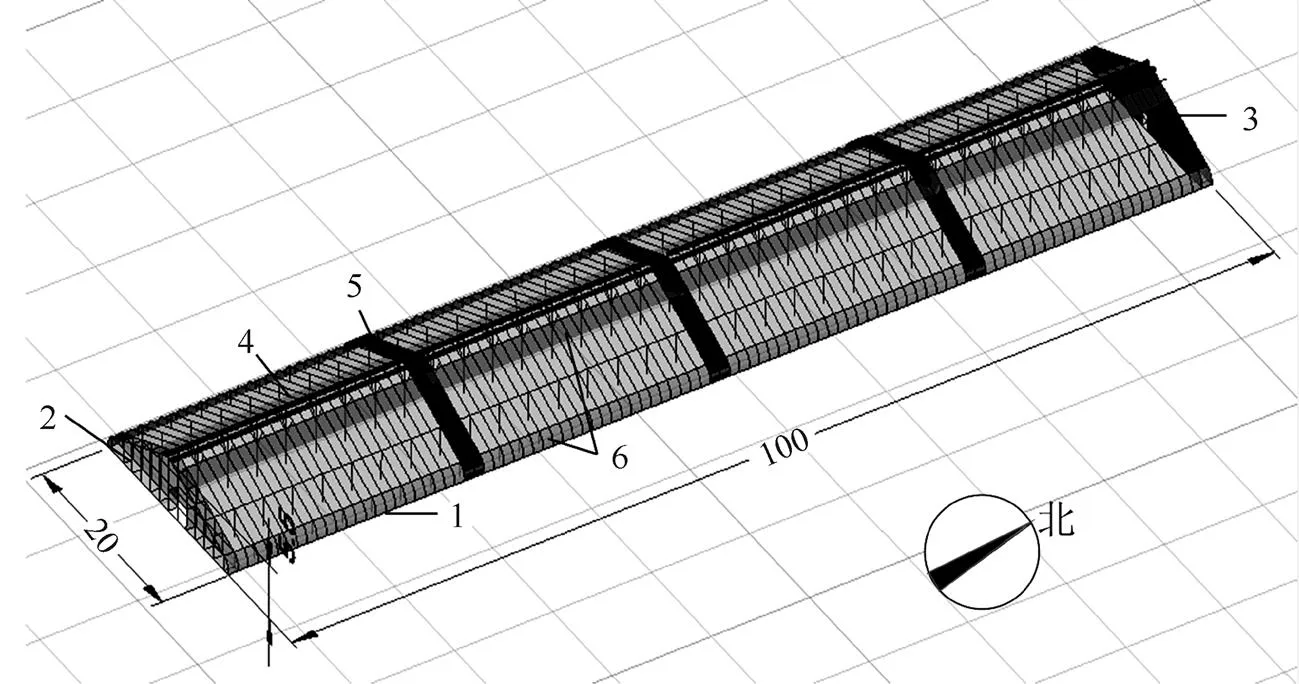
1.基础Foundation,2.南山墙South gable,3.北山墙North gable,4.支撑结构Supporting structure,5.外保温系统External insulation system,6.通风口Vent
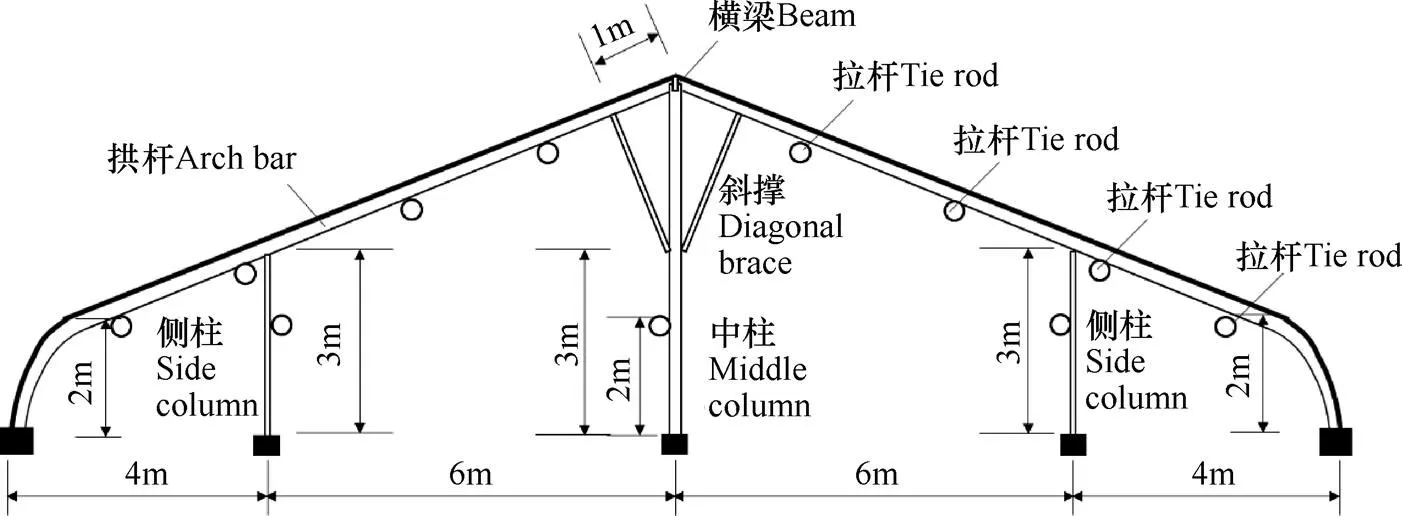
图2 供试WSTP大棚支撑结构示意图
1.2 性能测试方法
供试大棚内小气候环境的监测指标包括周年室内外气温、室内外10cm地温、室内相对湿度、棚内光照度和阴影宽度。试验区建设有20栋WSTP大棚,按不同收获期种植番茄,保证周年供应。为减少作物对监测数据的影响,当所监测温室内作物拉秧后,将仪器移到同一批建造相同规格的棚内进行监测。选取大棚内距南侧40m处纵剖面布置测点,测点布置情况如图3所示。室内外气温和地温监测采用热电偶测温仪(锦州,CB-0232),每个测点布置3个温度探头,相对湿度监测使用3台温湿度记录仪(华图HUATO HE-173),记录时间间隔均为30min,测试时间为2018年8月3日-2019年8月1日。光照度监测使用手持式照度计(SMART SENSOR AS803),在2018年8月-2019年8月期间的立秋(8月8日)、秋分(9月22日)、立冬(11月7日)、冬至(12月22日)、立春(2月4日)、春分(3月21日)、立夏(5月5日)、夏至(6月22日)前后分别选择晴天和阴天,人工测量该剖面9个点位1.5m高处水平面的光照度,分析不同季节棚内光环境特点。在秋分、立秋、冬至、清明4个节气利用卷尺实地测量棚内阴影位置和宽度。
1.3 数据处理
使用Excel 2016进行数据整理及分析。根据云量的观测情况和日照时数,将试验期间的天气类型划分为晴天、多云和阴天[12]。冬季白天是指8:30- 16:30,夜间是指16:30-次日8:30;夏季白天是指7:00-19:00,夜间是指19:00-次日7:00[2]。
2 结果与分析
2.1 WSTP大棚内温度特征
2.1.1 棚内气温和地温年变化
统计棚内平均温度、最高温度和最低温度的周年变化如表1所示。可以看出,WSTP大棚内最低月平均气温和地温均出现在1月,分别为10.9℃和12.7℃,分别较露地温度高8.5℃和9.6℃。WSTP大棚内最高月平均气温和地温出现在7月,分别为30.4℃和31.2℃,分别较露地温度高1.2℃和2.6℃。1月棚内日最低气温均值和最低地温均值为6.8℃和12.3℃,分别较露地高8.9℃和9.5℃。7月棚内日最高气温均值和最高地温均值为41.6℃和35.0℃,分别较露地气温高3.2℃和4.3℃。其中,6月露地地温高于室内地温,可能是由于当时园区室外进行了除草,室外无植被,造成露地温度较高。
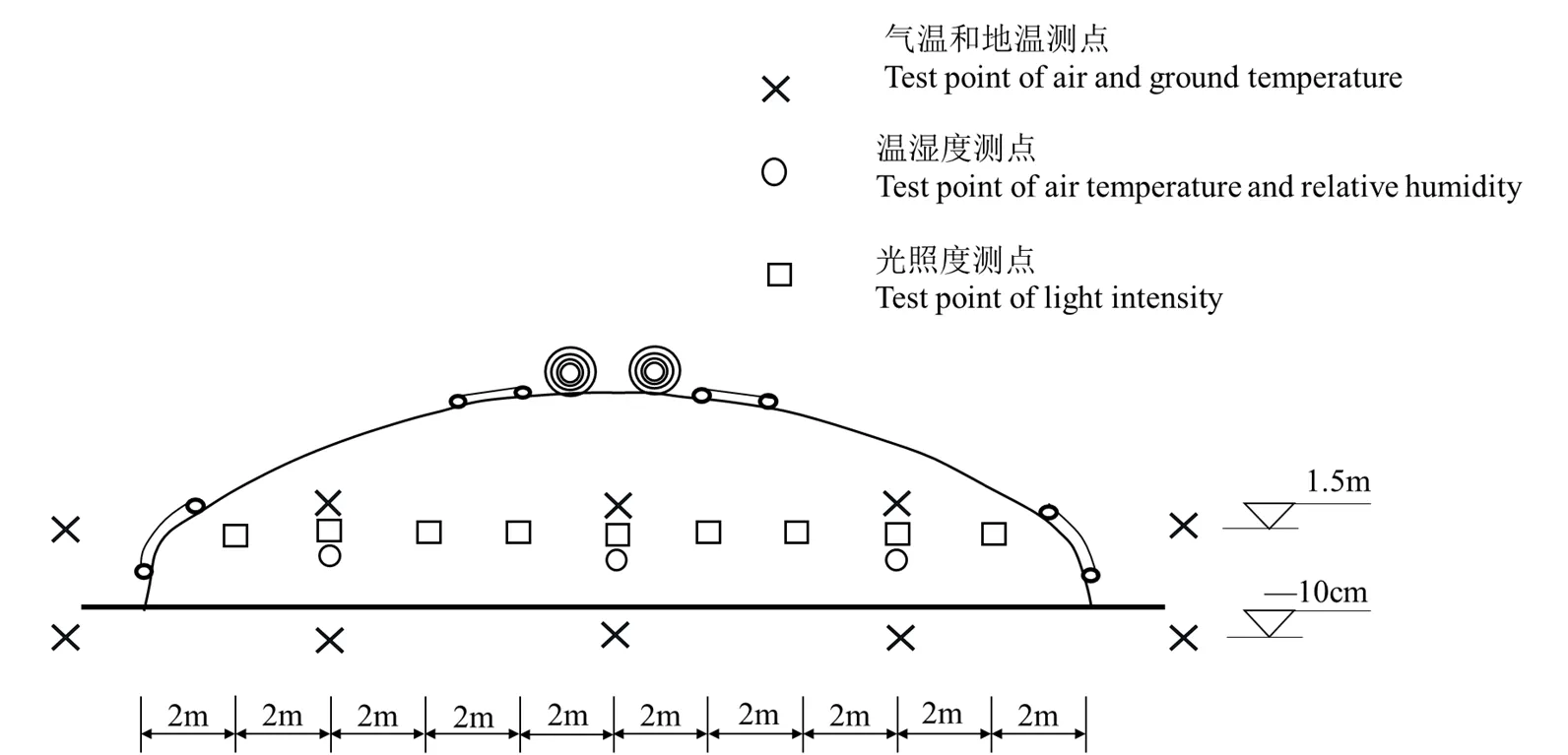
图3 WSTP棚内小气候测点分布
注:“×”表示棚内外气温和地温测点,“○”表示相对湿度测点,“□”表示光照测点。
Note: ‘×’ represents the test points of air temperature at 1.5m height and soil temperature at 10cm inside/outside WSTP, ‘○’ represents test point of air relative humidity, ‘□’ represents the test points of the light intensity.
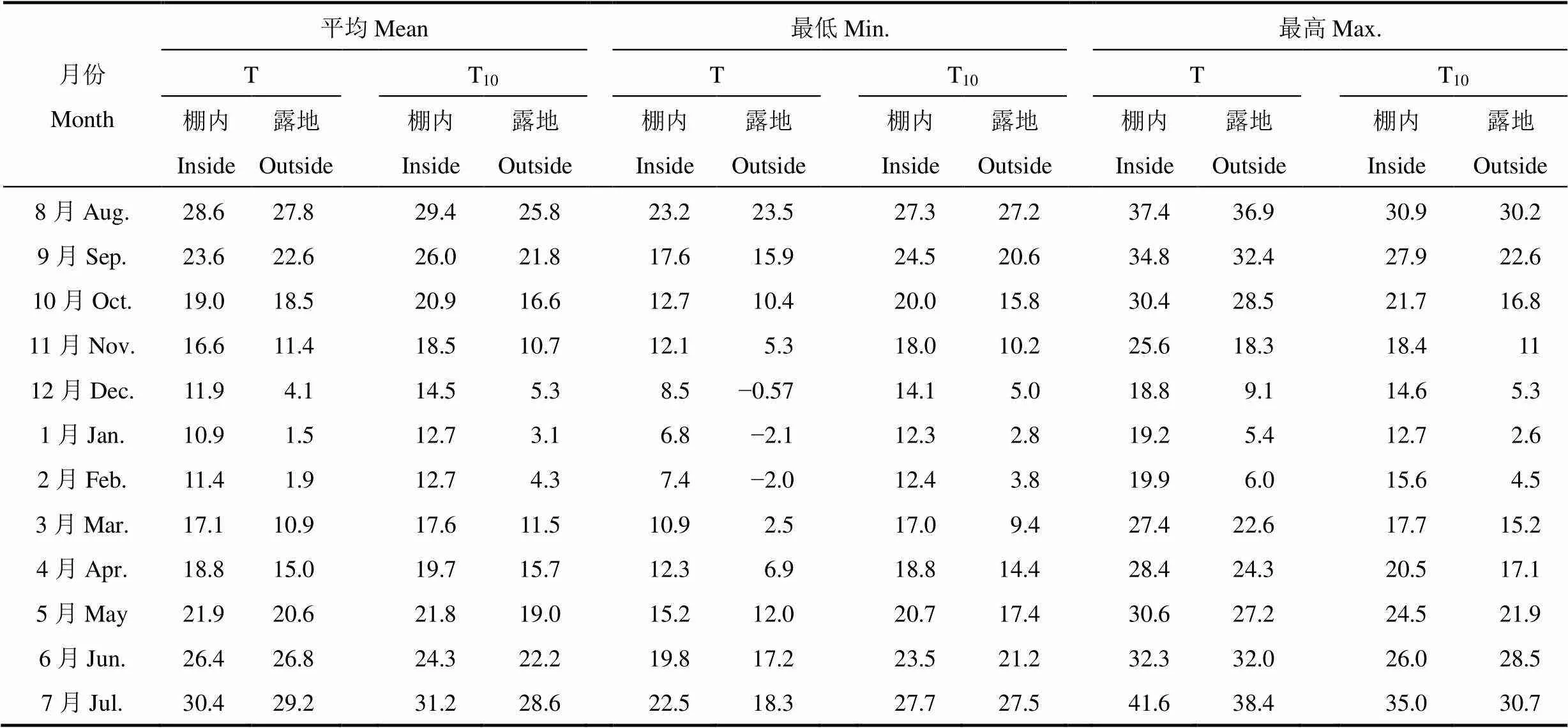
表1 全年各月棚内/外气温(T)和10cm地温(T10)变化(℃)
可以看出,棚内周年气温和地温始终高于露地。WSTP大棚冬季保温性能良好,棚内地温高且稳定。夏季室内气温和室内地温均高于露地,气温高出幅度较小,地温高出露地幅度大。
2.1.2 棚内气候学季节划分
按照气候学的季节标准[13],进行了棚内外气候学季节划分,如表2所示。可以看出,棚内外2018

表2 棚内外气候学季节划分对比
注:表中季节的顺序按照数据测试顺序列出。
Note: The order of seasons in the table is listed in order of data test.
年夏季结束时间相同,棚内气候学秋季延长至2019年1月6日,相比棚外延迟了41d;棚内气候学冬季在2019年1月6日开始,较露地延迟了41d;棚内气候学春季在2019年2月11日开始,较露地提早了33d。棚内气候学冬季时长仅36d,较外界减少了74d,相应地,棚内气候学秋季和春季分别延长41d和33d。可见,与外界相比,WSTP大棚能显著增加春秋季的时长,减少冬季时长,有利于寒冷时节进行设施栽培。
2.2 WSTP棚内湿度特征
2.2.1 棚内空气相对湿度年变化
从表3可以看出,全天棚内平均空气相对湿度在76.0%~98.8%变化,其中,11月-翌年2月棚内相对湿度平均为97.3%。白天棚内空气相对湿度周年变化范围较大,在61.8%~97.7%变化,其中11月-翌年2月平均值为94.8%,其它月份棚内相对湿度较低,在61.8%~76.2%之间变化,平均为66.2%。夜间棚内空气相对湿度全年均较高,在89.5%以上,平均为95.3%,其中,11月-翌年2月平均高达99.8%。可见,全天、白天和夜间棚内空气平均相对湿度均高于露地。11月-翌年2月期间,白天和夜间棚内相对湿度均接近饱和。
2.2.2 棚内高湿时期叶片沾湿时长
根据叶面结露%RH模型[14-15],对棚内高湿时期(10月-翌年3月中旬)作物叶片沾湿时长、旬叶片沾湿时间比进行分析,由表4可知,11月上旬-翌年2月下旬白天棚内的叶片沾湿时长比在62.0%~100%。此阶段棚外温度低,通风不及时,棚内白天叶片沾湿的发生时间在60%以上。10月下旬-3月上旬夜间棚内的叶片沾湿时长比均为100%,夜间棚内作物叶面均为结露的状态。可见,此段时间棚内湿度对作物生长不利。
2.3 WSTP棚内光照特征
2.3.1 典型节气典型天气棚内光照度日变化
图4和图5显示了棚内立秋、秋分、立冬、冬至、立春、春分、立夏和夏至8个节气前后晴天和阴天的光照度和透光率。由图4可看出,晴天时,棚内光照度和透光率均表现为8:00后逐渐增大,12:00达最大,之后逐渐降低的特点。自立秋开始各节气棚内日平均光照度为80753、73988、46256、25479、290111、59908、72062、84217Lux,平均透光率分别为67.3%、65.7%、54.7%、51.8%、53.3%、53.8%、59.4%、67.5%。立冬、冬至、立春全天内大多时段大棚透光率低于60%,立秋、夏至、立夏、春分则大于60%。从图5可看出,阴天时,自立秋开始各节气棚内日平均光照度为18149、9152、3567、2598、5399、3390、17638、8577Lux,平均透光率分别为60%、72%、71%、59%、60%、44%、63%、60%。可见,棚内光照度存在日变化和季节变化特点,日变化规律与外界一致,季节变化方面,冬至日的光照度和透光率均为最低,棚内冬春季节透光率整体低于立秋、夏至、立夏几个节气。由于阴天主要是散射光,大棚透光率的日变化规律性不明显。
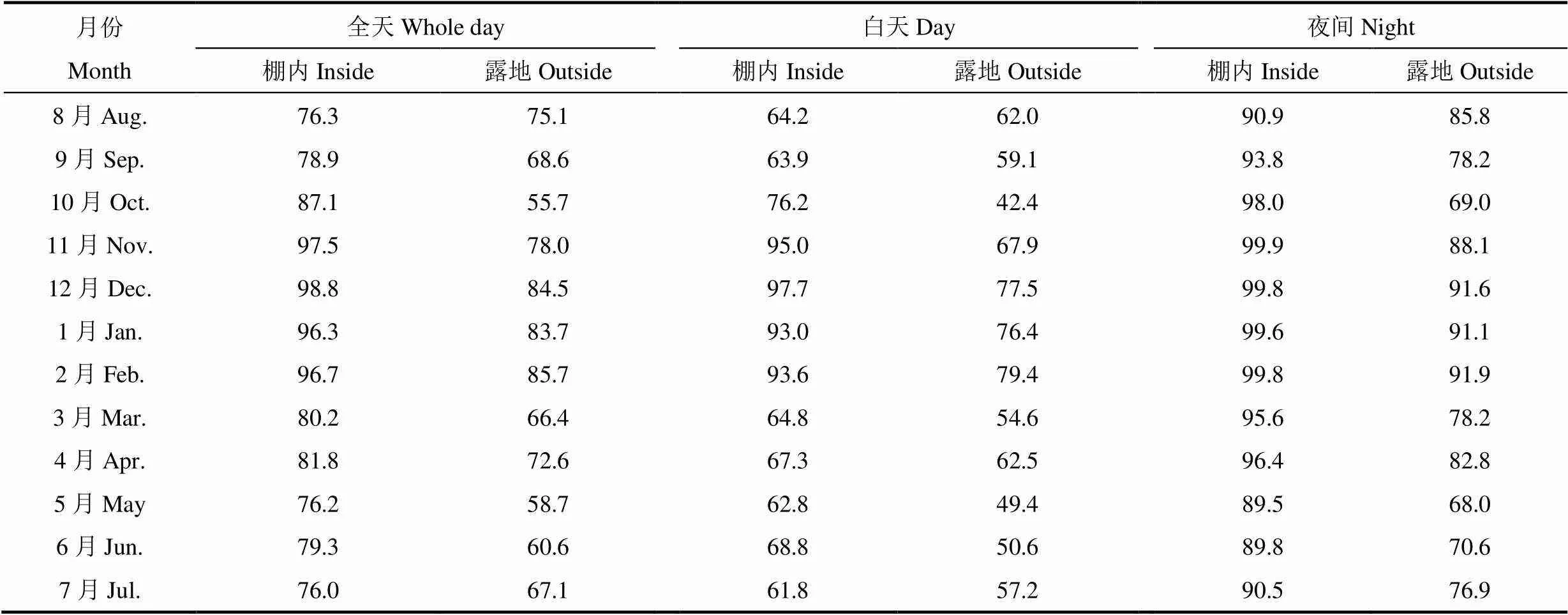
表3 全年各月棚内/外空气相对湿度变化(%)

表4 10月-翌年3月棚内叶片结露沾湿时长百分比(%)

注:旬叶片沾湿时间比(%)=旬内结露累计时长/旬时长×100。
Note: The proportion of leaf wetness duration every ten days(%)=cumulative leaf wetness duration in ten days/total duration of ten days×100. E- is the first ten-day of a month, M- is the middle ten-day of a month, L- is the last ten-day of a month.O is outside and IN is inside WSTP.
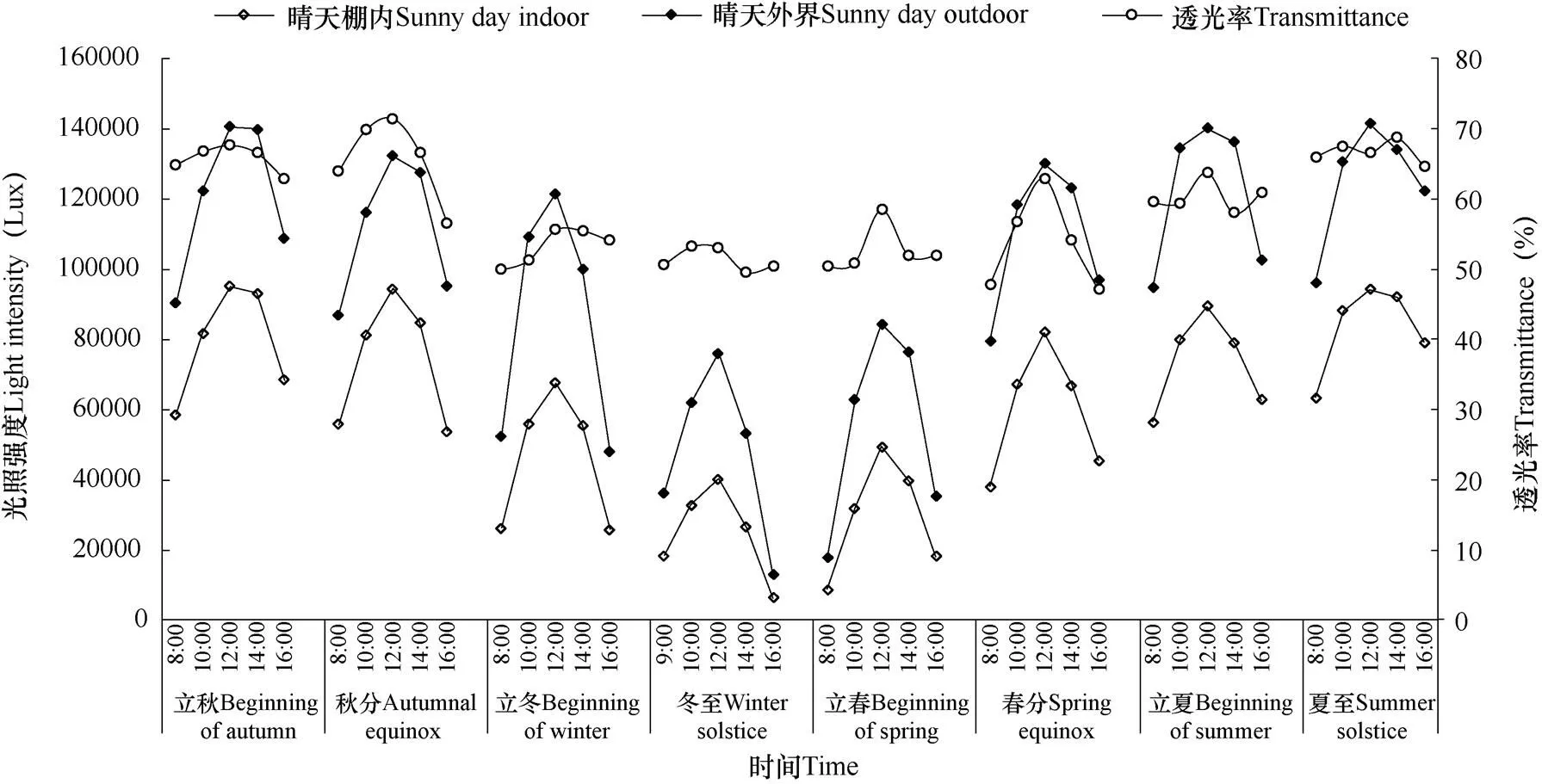
图4 典型节气晴天WSTP棚内外光照度和透光率的日变化
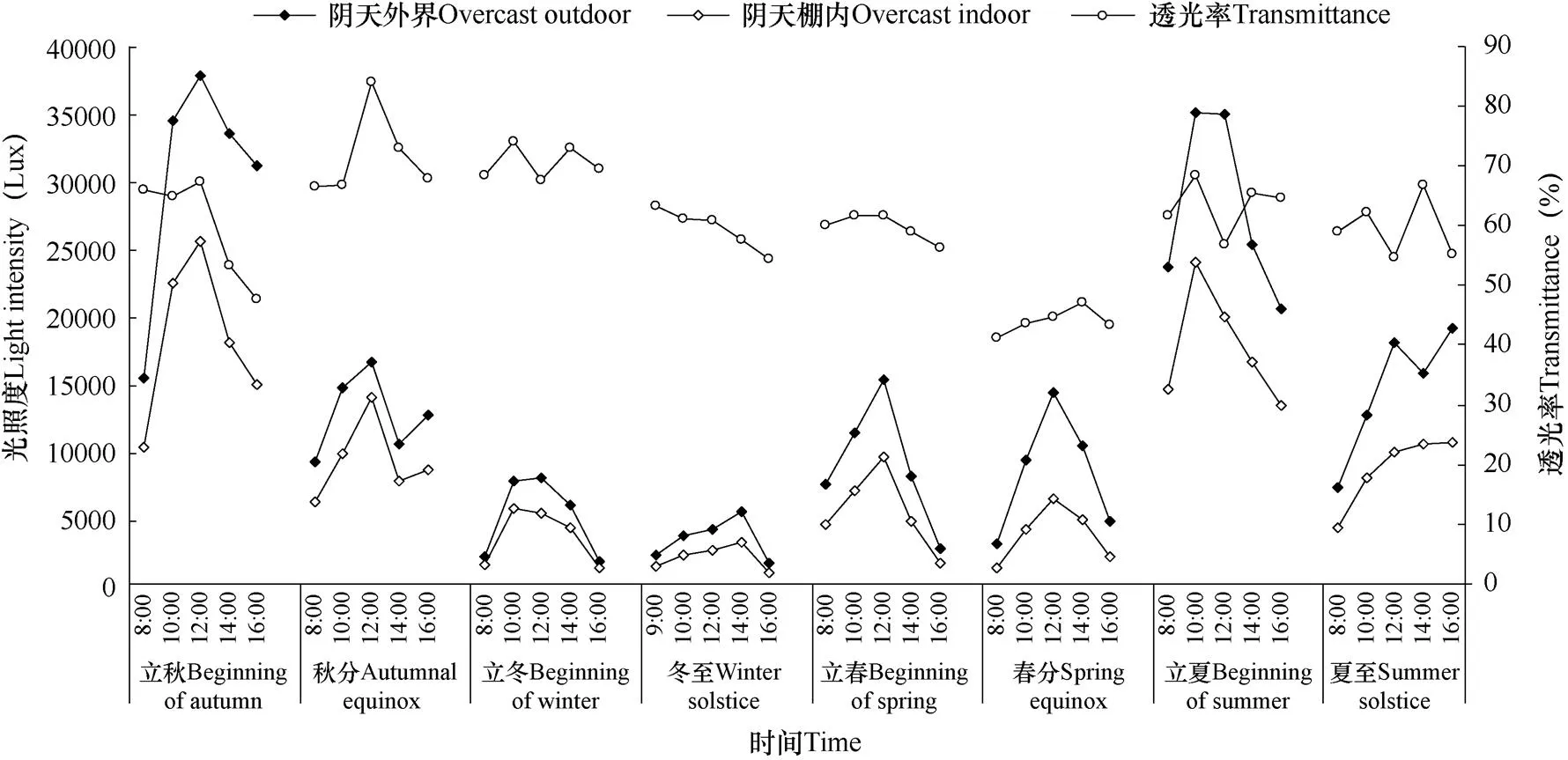
图5 典型节气阴天WSTP棚内外光照度和透光率的日变化
2.3.2 棚内保温被卷阴影位置和宽度
从图6可以看出,白天保温被卷起后,放置于大棚顶部,形成一条遮光带。秋分、立秋、冬至、清明4个典型节气前后对保温被卷在棚内形成的阴影位置和宽度进行观测,由表5可见,受太阳运行规律的影响,保温被卷的阴影位置和宽度随时间和季节均会发生变化,阴影位置随太阳方位角的变化而移动,8:00-12:00阴影位置在大棚西侧,12:00- 16:00在大棚东侧。秋分和清明节气,8:00前和16:00后阴影在棚室外。全天棚内阴影宽度在2~3.5m区间变化。可见,上卷下铺式保温被收起后在棚内形成一条阴影,但位置会随着太阳的运行规律移动,不会产生静止不动的“死阴影”。
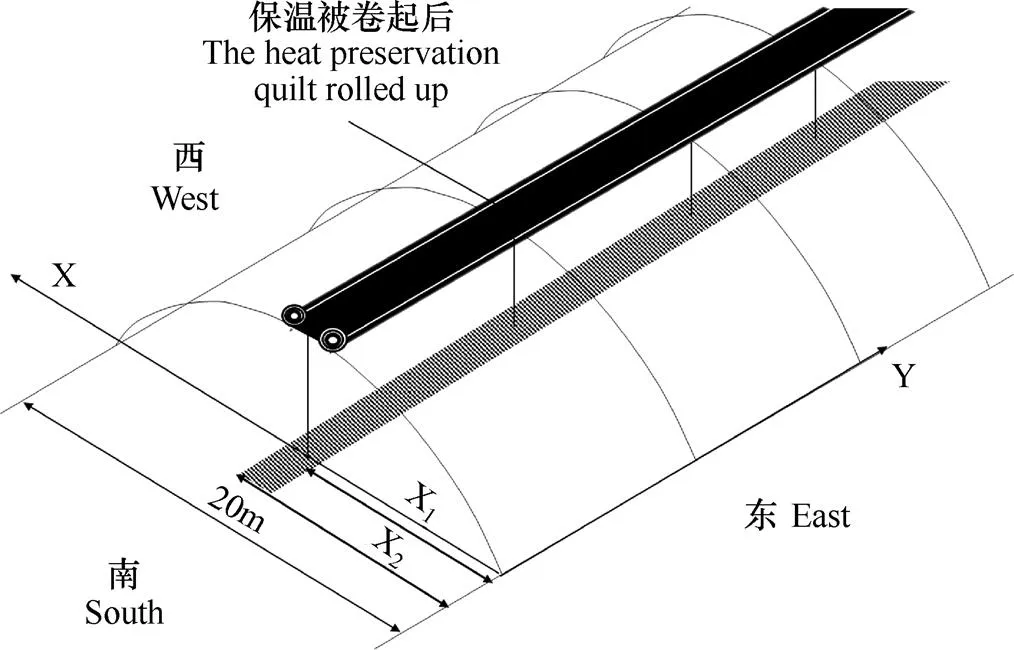
图6 保温被卷在棚内形成阴影的坐标表示法
注:X1和X2表示保温被卷起后形成的阴影位置,0≤X1,X2≤20。X2和X1的差值为阴影宽度。
Note:X1and X2indicate the shadow position of heat preservation quilt roll, 0≤X1, X2≤20. The difference between X2and X1is the shadow width.

表5 四个典型节气保温被卷阴影位置和宽度的日内变化(m)
注:0.0、20.0分别表示部分、全部阴影不在大棚内。
Note: 0.0 and 20.0 respectively indicate that some and all shadow is not in the shed.
3 结论与讨论
3.1 讨论
大跨度外保温型塑料大棚相较普通日光温室来说,棚内作业空间大、土地利用率高、成本低、建造速度快,在河南山东多地都有应用。本研究对WSTP大棚内温度进行周年监测发现,1月WSTP大棚内外最低气温和地温差为8.9℃和9.5℃。同时期,郜庆炉等在河南省新乡市监测到普通日光温室内外温差为8~11.8℃[16];王倩等在河南省荥阳市监测到下沉式日光温室内1月平均最低气温为7.35℃,室内外最低温差为12.34℃[17]。可以看出,WSTP大棚的保温能力与普通日光温室相近,比下沉式日光温室略低。
园艺设施的主要功能是为作物提供适宜的环境条件,其中最重要的是温度和光照环境。以喜温类果菜为例,番茄定植时要求温室内极端最低气温应保持在5℃以上,10cm地温稳定在10℃以上[18]。WSTP大棚内1月平均最低气温和地温分别为6.8℃和12.4℃,地温高且稳定。相较气温,根际温度对整个植株生长的影响更大,根系生长要求比较稳定的根际温度。即使气温超过或低于作物生长的要求,只要有适宜稳定的根际温度,作物生长也不会有太大的影响[19]。番茄的光饱和点为70000Lux,光补偿点为2000Lux。冬至前后WSTP大棚内晴天和阴天平均光照度为25479Lux和2598Lux,平均透光率为51.8%。对比可看出,WSTP大棚内可进行番茄等喜温果菜的周年栽培。结合实际生产经验,试验WSTP大棚内进行番茄栽培,冬春茬可于2月中下旬定植,6月下旬拉秧;秋冬茬可于8月下旬定植,翌年1月中旬拉秧,利用总时长在250d左右。河南地区日光温室番茄栽培时,冬春茬可于2月上旬定植,6月中旬拉秧;秋冬茬可于8月下旬定植,翌年1月中旬拉秧,全年利用总时长在260d左右。可以看出,利用WSTP大棚进行一年两茬的栽培生产,与日光温室区别不大,能够满足当地设施生产的需求,具有一定的实用价值。
园艺设施作为一种封闭或半封闭的系统,其内部空气相对湿度较大。WSTP大棚同样具有这样的特点,10月下旬-3月上旬棚内夜间作物叶面均为结露的状态,白天叶面沾湿发生时间也在一半以上,形成有利于病原侵害的微环境[20]。湿度过高还容易造成作物徒长、开花结实差、生理功能减弱等,使产量和品质受到影响。这主要是由于这段时间棚内温度较低,不能大面积开窗通风除湿,所以在栽培生产管理中应注意相对湿度的调控,可采用膜下滴灌、栽培行间覆盖秸秆、白天在保证温度的前提下尽可能早地打开顶通风口等方式,多措施结合排除水蒸气,降低湿度。
3.2 结论
(1)WSTP大棚具有一定的保温增温能力,接近普通日光温室。晴天棚内的透光率为51.8%~67.5%,存在一条移动阴影带,但不会形成“死阴影”。该类大棚能为喜温类果菜提供必要的环境条件,可进行喜温果菜的周年栽培,具有推广价值。
(2)WSTP大棚内相对湿度大,11月-翌年2月白天和夜间棚内相对湿度均接近饱和,生产中要多措施结合降低湿度。
WSTP大棚仍存在有41d的低温期。若利用该大棚进行越冬茬栽培,冬季保温性能仍有待提高,夏季棚内也存在高温的问题,可通过冬季增加内覆盖、夏季利用保温被适当遮阳等简易调控措施,创造更适宜的栽培环境,但具体管理手段仍有待进一步探索。
[1] 郭世荣,孙锦,束胜,等.我国设施园艺概况及发展趋势[J].中国蔬菜,2012(18):1-14.
Guo S R,Sun J,Shu S,et al.Analysis of general situation, characteristics,existing problems and development trend of protected horticulture in China[J].China Vegetables,2012 (18):1-14.(in Chinese)
[2] 王军伟,洪忠举,郭世荣,等.冬夏兼用型日光温室内热湿性能分析与应用效果[J].农业工程学报,2016,32(23):190- 198.
Wang J W,Hong Z J,Guo S R,et al.Temperature humidity performance and application of solar greenhouse suiting for winter and summer[J].Transactions of the CSAE,2016, 32(23):190-198.(in Chinese)
[3] 唐中祺.不同跨度日光温室结构设计及升温保温性能研究[D].兰州:甘肃农业大学,2014.
Tang Z Q.Study on the physical design and the warming and thermal insulation properties in the solar greenhouse of different span[D].Lanzhou:Gansu Agricultural University, 2014.(in Chinese)
[4] 赵鹏,宋明军.组装式涤棉墙体日光温室热湿环境及生产性能分析[J].中国农机化学报,2018,39(6):44-47.
Zhao P,Song M J.Test and analysis of the modularcotton- polyester wall solar greenhouse thermal performance[J]. Journal of Chinese Agricultural Mechanization,2018,39(6): 44-47.(in Chinese)
[5] 周波,张义,方慧,等.装配加温除湿系统的轻简装配式日光温室设计及性能试验[J].农业工程学报,2016,32(11): 226-232.
Zhou B,Zhang Y,Fang H,et al.Performance experiment and design of simply assembled Chinese solar greenhouse equipped with heating and dehumidification system[J]. Transactions of the CSAE,2016,32(11):226-232.(in Chinese)
[6] 闫俊月,李明,张秋生,等.“西北非耕地温室结构与建造技术”项目成果汇报(4):轻简化装配式后墙[J].农业工程技术,2014,(4):62-63.
Yan J Y,Li M,Zhang Q S,et al.Project Report on "structure and construction technology of greenhouses built on uncultivated area in Northwest China(4):simplified and assembled back wall[J].Agricultural Engineering Technology, 2014,(4):62-63.(in Chinese)
[7] 李胜利,季军,孙治强,等.巨型塑料大棚温度性能研究[J].中国农业气象,2008,29(1):58-61.
Li S L,Ji J,Sun Z Q,et al.A study on temperature performances of widespan plastic covered tunnel greenhouse[J].Chinese Journal of Agrometeorology,2008, 29(1):58-61.(in Chinese)
[8] 崔世茂,陈源闽,霍秀文,等.大棚型日光温室设计及光效应初探[J].农业工程学报,2005,21(S2):214-217.
Cui S M, Chen Y M, Huo X W, et al. Design of the solar lean-to greenhouse without wall and preliminary study on the photoeffect[J].Transactions of the CSAE,2005,21(S2): 214-217.(in Chinese)
[9] 武莹,李建明,肖金鑫,等.新型大跨度非对称塑料大棚内冬季温光变化特征研究[J].西北农林科技大学学报(自然科学版),2019,47(6):97-106.
WU Y,Li J M,Xiao J X,et al.Winter temperature and sunlight variation characteristics in large-span asymmetric plastic greenhouses[J].Journal of Northwest A & F University(Natural Science Edition),2019,47(6):97-106.(in Chinese)
[10] 韩丽蓉,王宏丽,李凯,等.下沉式大跨度大棚型温室的设计及应用研究[J].中国农业大学学报,2014,19(4):161-165.
Han L R,Wang H L,Li K,et al.Design and application study on the sinking and great-span greenhouse without back wall [J].Journal of China Agricultural University,2014, 19(4):161-165.(in Chinese)
[11] 周长吉.周博士考察拾零(七十五):大跨度保温塑料大棚的实践与创新(上)[J].农业工程技术,2017,37(34):20-27.
Zhou C J.Note of Dr. Zhou(75) practice and innovation of with large span plastic greenhouse external thermal insulation[J].Agricultural Engineering Technology,2017, 37(34):20-27.(in Chinese)
[12] 金志凤,叶建刚,杨再强,等.浙江省茶叶生长的气候适宜性[J].应用生态学报,2014,25(4):967-973.
Jin Z F,Ye J G,Yang Z Q,et al.Climate suitability for tea growing in Zhejiang Province[J].Chinese Journal of Applied Ecology,2014,25(4):967-973.(in Chinese)
[13] 中国气象局.气候季节划分QX/T 152-2012[M].北京:气象出版社,2012:2.
China Meteorological administration.Division of climate season QX/T 152-2012[M].Beijing :China Meteorological Press,2012:2.(in Chinese)
[14] 贺威威.日光温室黄瓜叶片结露模拟及通风调控[D].沈阳:沈阳农业大学,2018.
He W W.Simulation and ventilation regulation of the cucumber leaf dew in solar greenhouse[D].Shenyang Shenyang Agricultural University,2018.(in Chinese)
[15] Sentelhas P C,Marta A D,Orlandini S,et al.Suitability of relative humidity as an estimator of leaf wetness duration[J].Agricultural & Forest Meteorology,2008,148(3): 1-400.
[16] 郜庆炉,薛香,段爱旺.日光温室内温度特点及其变化规律研究[J].灌溉排水学报,2003,(6):50-53.
Gao Q L,Xue X,Duan A W.Temperature characteristics and its changing laws within solar plastic greenhouse[J]. Journal of Irrigation and Drainage,2003,(6):50-53.(in Chinese)
[17] 王倩,张海涛,刘旭,等.下沉式日光温室内温光环境分析[J].中国农业气象,2013,34(1):37-42.
Wang Q,Zhang H T,Liu X,et al.Analysis on temperature and light in sinking solar greenhouse[J].Chinese Journal of Agrometeorology,2013,34(1):37-42.(in Chinese)
[18] 钟凤林,林义章.设施植物栽培学[M].北京:科学出版社,2017:117-119;131-134.
Zhong F L,Lin Y Z.Protected cultivation of plant [M]. Beijing:Science Press,2017:117-119;131-134.(in Chinese)
[19] 李式军.设施园艺学[M].北京:中国农业出版社,2011: 163;238-240.
Li S J.Protected horticulture[M].Beijing:China Agriculture Press,2011:163;238-240.(in Chinese)
[20] 李明,赵春江,乔淑,等.基于冠层相对湿度的日光温室黄瓜叶片湿润时间估计模型[J].农业工程学报,2010,26(9): 286-291.
Li M,Zhao C J,Qiao S,et al.Estimation model of leaf wetness duration based on canopy relative humidity for cucumbers in solar greenhouse[J].Transactions of the CSAE,2010,26(9):286-291.(in Chinese)
Microclimate Environment Test for Wide-span Plastic Greenhouse with External Thermal Insulation
DONG Xiao-xing1, HUANG Song2, YU Lu-ming1, LI Sheng-li1
(1.Horticultural College, Henan Agricultural University, Zhengzhou 450002, China;2. Xinyang Agricultural and Forestry University, Xinyang 464000)
Agricultural facilities will be improved to be more large-scale, simplified, lighter and easier to be assembled as facility agriculture production moves towards mechanization and intensification. As the most important type of horticultural facility in northern China, solar greenhouses are mainly used for the annual production of warm-season vegetables. However, the span of solar greenhouses are mostly 8-10m, and the back wall are mainly made of clay or brick. All these result in the small cultivation area, low efficiency of wall construction and low utilization of land. In addition, plastic greenhouses have poor thermal insulation property and cannot be used in winter in northern China. Therefore, neither of these two common facilities can meet the production requirements. The large-span plastic greenhouses with external thermal insulation property are designed and put into practice. The span is extended from 8-12m to 20m and external thermal insulation system is equipped. They have a north-south orientation, steel structure skeleton and bolt connection, with the advantages of strong temperature buffering capacity, high land utilization rate, low production cost and high degree of assembly. However, the internal microclimate environment is not clear, that makes it impossible to produce scientifically. In order to find out the microclimate environment in the large-span external thermal insulation plastic greenhouse and effectively guide the cultivation. The microclimate environment, such as temperature, ground temperature, relative humidity and light conditions inside and outside the greenhouse had been monitored annually. And the application prospect of the new greenhouse had been discussed. The calculation showed that new plastic greenhouse had good heat-insulating property in winter. The average temperature indoor in January was 10.9℃, and the average ground temperature indoor was 12.7℃. The lowest indoor temperature was 6.8℃, and the lowest indoor ground temperature was 12.3℃, which were 8.9℃ and 9.5℃ higher than the open ground. In summer, the air and ground temperature in the shed was higher than the open field, but the raise of air temperature was smaller, and the ground temperature was slightly larger. The relative humidity in the shed was large, which was close to saturation in the day and night during November to following February. The light transmittance of the shed was 51.8%-67.5% in sunny days. There was a moving shadow band of 2.0-3.5m wide. The study showed that microclimate environment in the new greenhouse could basically meet the requirements of warm-season vegetables. In some areas of Zhumadian city, large-span external thermal insulation plastic greenhouses could basically meet the environmental conditions required for thermophilic fruits and vegetables, and could be used for their annual production.
Wide-span; External thermal insulation; Plastic greenhouse; Temperature; Relative humidity; Light intensity
10.3969/j.issn.1000-6362.2020.07.002
董晓星,黄松,余路明,等.大跨度外保温型塑料大棚小气候环境测试[J].中国农业气象,2020,41(7):413-422
2020-03-16
李胜利,E-mail:lslhc@yeah.net
河南省大宗蔬菜产业技术体系专项(S2010-03-03)
董晓星,E-mail:wuxian_mige@163.com;并列第一作者黄松,E-mail:13803862987@126.com
